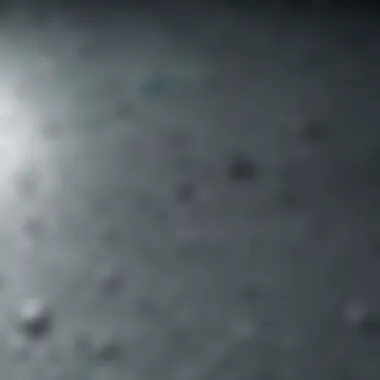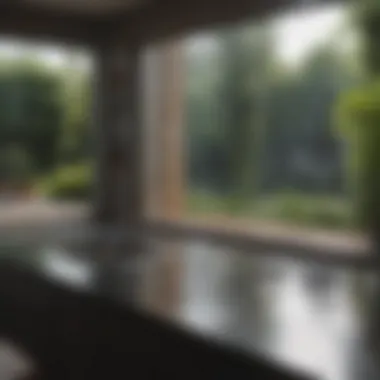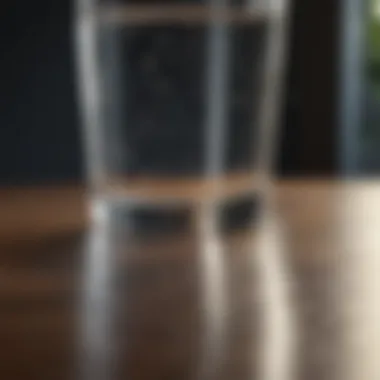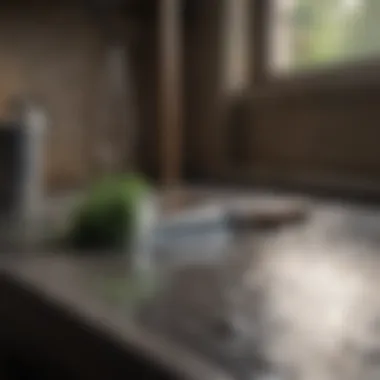Effective Methods for Removing Stubborn Water Stains


Intro
Water stains on glass are a prevalent issue that many homeowners face. These stubborn marks often form due to hard water, which leaves mineral deposits. These deposits result from water evaporation, combining calcium and magnesium that remain on the surface. The presence of such stains not only detracts from the overall aesthetic of a home but can also be a source of frustration.
Achieving spotless glass can significantly enhance the look of specific areas in your living space, such as windows, shower doors, and glass tabletops. This article will provide you with effective methods for removing those annoying water stains. By understanding the various techniques available, you can choose the one that best suits your needs while ensuring a clear, sparkling finish on your glass surfaces.
Prelude to Water Stains on Glass
Water stains on glass are an all-too-familiar sight for homeowners and anyone who values clear, clean surfaces. These stains are not merely a cosmetic issue; they reflect broader questions of maintenance, care, and the overall presentation of one’s living space. Understanding the dynamics of water stains is crucial, especially if one desires a pristine look in any environment.
When we discuss water stains, we delve into a variety of factors, including the reasons why they occur and their potential long-term effects. It is beneficial to recognize that water stains can accumulate over time, leading to more than just unsightly marks. They can demonstrate lack of maintenance, or worse, indicate that glass surfaces could be subject to deterioration if neglected.
The importance of this topic cannot be overstated. For interior design enthusiasts, the appearance of glass—be it in windows, shower doors, or mirrors—is often linked to the overall aesthetic of the space. A clear glass surface not only enhances natural light but also contributes to a sense of cleanliness and order. Homeowners, particularly those who host gatherings or parties, should consider how these details impact their guests' impressions.
By understanding how to manage and remove water stains effectively, individuals can take proactive steps toward maintaining their spaces. This knowledge can empower readers to tackle glass staining issues confidently, ensuring their environments remain welcoming and visually appealing.
Impact of Water Stains on Glass
Water stains are more than just an aesthetic issue. Their presence on glass surfaces can significantly impact not only the visual appeal but also the longevity of the glass itself. Understanding this impact is crucial for homeowners and anyone involved in maintaining the visual integrity of their environment.
Aesthetic Concerns
One of the most immediate effects of water stains on glass is their influence on appearance. Stains can create an unsightly film that interrupts the clarity of windows, mirrors, and other glass surfaces. This disruption can diminish the overall atmosphere of a room, making spaces feel unkempt. When entertaining guests or simply enjoying one’s home, the visual cleanliness of glass surfaces can create a stark contrast.
Additionally, stained glass can undermine the design efforts of a space. Clear, spotless glass contributes to a modern and polished look, while stained glass may evoke neglect or poor maintenance. The cleanliness of glass is often a reflection of the overall care put into a home or establishment.
Damage to Glass Over Time
While the aesthetic concerns are front and center, water stains also harbor potential long-term implications. Mineral deposits within the stains can over time lead to etching or pitting of the glass surface. This damage can create permanent marks that cannot be remedied through simple cleaning methods. When left untreated, these stains may escalate maintenance costs if replacement becomes necessary.
Moreover, repeated exposure to harsh chemical cleaners used in an attempt to remove these stains can further accelerate the degradation of the glass. The layer of grime strengthens the bond between the stain and the glass over time, making removal increasingly challenging.
Tools and Materials for Removal
The efficacy of removing stubborn water stains from glass hinges significantly on the tools and materials employed in the process. Selecting appropriate items can enhance cleaning efficiency, minimize the risk of damage, and yield noticeable results with minimal effort. Homeowners often find themselves at crossroads, choosing between common household products or specialized commercial solutions. In this section, we will explore the advantages of both approaches, providing clarity on what items are most effective for various situations. Understanding these tools also allows for better preparation and a smoother cleaning experience.
Household Items
Many effective cleaning solutions are found within the average household. Utilizing these items has both economical and environmental benefits. Ingredients like vinegar and baking soda are known for their stain-fighting properties.
- Vinegar: Its acidic nature helps break down mineral deposits, making it a primary choice for tackling water stains.
- Baking Soda: This mild abrasive can gently scrub off stubborn stains without scratching glass surfaces. It can be made into a paste that clings to stains for enhanced effectiveness.
- Lemon Juice: Another natural acid, lemon juice can dissolve some stubborn deposits while leaving a fresh scent.


Using these household items, homeowners can often achieve satisfactory results without needing to purchase additional products. This strategy is not only cost-effective but also reduces reliance on chemical cleaners, which may have adverse environmental impacts.
Commercial Cleaning Solutions
For those dealing with particularly persistent water stains, commercial cleaning solutions offer targeted action. These products often contain specific ingredients designed to break down mineral deposits more effectively than household alternatives. CLR (Calcium, Lime, and Rust Remover) and Rain-X are notable examples of such cleaners.
- Pros:
- Cons:
- Formulated specifically for tough stains.
- Quick-action formulas can save time.
- May offer protective coatings that guard against future stains.
- Some may contain harsh chemicals that can pose risks if misused.
- More expensive than household options.
It is vital to follow instructions carefully when using commercial products and to choose solutions that specify they are safe for glass surfaces. Careful selection here can provide an effective remedy without leading to unwanted side effects.
Protective Equipment
While cleaning glass, the use of protective equipment is often overlooked. However, wearing the right gear is essential for safety and health.
- Gloves: Latex or rubber gloves should be worn to protect the skin from irritation, especially when using stronger commercial cleaners.
- Safety Glasses: If using chemical solutions that produce fumes, safety glasses help protect the eyes from accidental splashes.
- Mask: For those sensitive to smells or chemicals, wearing a mask provides an extra layer of safety.
These precautions are important not just to protect the individual performing the cleaning but also to ensure that the environment remains safe and pleasant.
In summary, choosing the right tools and materials will not only facilitate the removal of stubborn water stains but will also enhance the overall safety and effectiveness of the process. Whether using basic household items or advanced commercial solutions, it is essential to be well-prepared and informed.
Step-by-Step Removal Techniques
The process of removing stubborn water stains from glass surfaces can seem daunting at first. However, breaking down the task into effective, methodical steps can turn the effort into a manageable process. This section outlines various techniques that homeowners can apply, detailing their benefits and considerations.
Using these methods not only enhances the appearance of glass but also prolongs its lifespan. On a day-to-day basis, maintaining clean glass can significantly improve natural light exposure in your home. This can contribute to a more inviting atmosphere, whether it be for gatherings or simply enjoying your living space.
Using Vinegar and Water Solution
One of the simplest yet effective methods for tackling water stains involves using a vinegar and water solution. Vinegar, known for its mild acidity, helps to break down mineral deposits commonly found in water stains. To create this cleaning solution, mix equal parts vinegar and water in a spray bottle. It is vital to use distilled vinegar, as it contains fewer impurities compared to cheaper options.
- Spray the solution generously onto the affected area of the glass, allowing it to sit for a few minutes. This lets the vinegar penetrate and loosen the stain.
- Wipe down with a soft cloth or sponge, working in circular motions to lift the stains effectively.
- Rinse the glass with clean water afterwards and dry with a lint-free cloth to avoid streaks.
This method is preferred for its environmental benefits and cost-effectiveness. However, it's important to test it on a small spot first to ensure that no damage occurs to special coatings on the glass.
Applying Baking Soda Paste
Baking soda paste serves as a slightly more abrasive option for removing stubborn stains. Baking soda is a gentle abrasive that can scrub away heavy deposits without scratching the glass.
To use this method:


- Combine baking soda with a small amount of water to form a thick paste. The consistency should be similar to toothpaste.
- Apply the paste directly to the stained areas. Focus on parts that seem more resistant.
- Use a soft cloth or sponge to gently rub the paste into the stains. Avoid excessive pressure to prevent scratching.
- Rinse thoroughly with water and dry with a cloth.
This technique can be useful for tougher stains. However, it requires more effort and careful application to avoid damaging the surface.
Utilizing Commercial Cleaners
For persistent stains that do not respond to home remedies, commercial cleaners can provide a more aggressive solution. These products are specifically formulated to target water stains and mineral build-up.
When choosing a commercial cleaner:
- Look for those labeled as safe for glass surfaces. Products like Krud Kutter or Glass Plus often come highly recommended.
- Read and follow the usage instructions carefully. This ensures maximum effectiveness while minimizing risks.
To apply:
- Spray the cleaner onto the stained area according to the manufacturer's guidelines.
- Allow it to sit for the recommended duration, which lets the chemicals work to break down the stains.
- Wipe with a microfiber cloth to achieve clarity and shine.
While more effective, remember that these cleaners often contain strong chemicals. Use protective gear if necessary, and ensure proper ventilation.
Incorporating Glass Scrapers
When conventional cleaning methods fail, incorporating a glass scraper can offer a solution for extreme cases. These tools can help to physically remove hard water stains and other build-up without the use of harsh chemicals.
To use glass scrapers safely:
- Ensure the glass surface is wet. This helps prevent scratching.
- Hold the scraper at a 45-degree angle and gently push it across the stained area. Use caution to avoid exerting too much pressure.
- Clean the area afterwards using one of the above methods for final touch-ups.
Keep in mind that glass scrapers should only be used on non-coated glass surfaces. For window films or treated glass, using scrapers can cause damage.
Tip: Always test any cleaning method on a small section first, especially when dealing with untreated or specialty glass surfaces. This helps to avoid unexpected damage and ensures you find the method that works best for your situation.
Preventive Measures Against Water Stains
Preventive measures against water stains are essential for maintaining the clarity and beauty of glass surfaces. By implementing effective strategies, homeowners can significantly reduce the occurrence of water stains. This not only enhances aesthetic appeal but also extends the life of the glass. Proactive measures save time and effort that would otherwise be spent on cleaning and restoring.
Choosing the Right Glass Treatment
Selecting an appropriate treatment for glass surfaces is a crucial step in prevention. Various coatings can be applied to glass to repel water and minimize mineral deposits that lead to stains. For example, hydrophobic treatments create a barrier that causes water to bead up and roll off, taking debris and minerals with it. Products such as Rain-X and Invisible Glass Water Repellent can be effective. These treatments need to be reapplied periodically, but the reduced need for scrubbing can make upkeep much simpler.
Additionally, considering the type of glass is vital. Some types, like tempered glass, may respond better to specific treatments. Researching and understanding the characteristics of the glass can lead to informed choices that yield optimal results.
Regular Cleaning Routines


Establishing a consistent cleaning routine is paramount. Routine cleaning prevents water stains from settling and becoming more difficult to remove. Ideally, cleaning glass surfaces should occur at least once a month, depending on factors like weather and location. During cleaning, a solution of vinegar and water effectively cuts through mineral deposits.
Also, it is beneficial to use soft cloths or microfiber cloths instead of rough materials that may scratch the glass. Using a squeegee after washing windows can also help. This tool removes excess water, minimizing potential stains and spots.
Regular cleaning significantly reduces the labor involved when facing stubborn stains in the future.
Water Softening Solutions
Using water softening solutions can greatly decrease the likelihood of developing stubborn water stains. Hard water contains high levels of calcium and magnesium, which can leave residues on glass. Installing a water softener in the home can prevent these minerals from affecting glass surfaces. This system works by ion exchanging, removing the hardness before it reaches faucets and fixtures.
In addition to systems, there are also simpler methods, such as using table salt or vinegar in the laundry to treat hard water. Homeowners might also consider descaling agents specifically designed for household appliances and surfaces to combat the hardness effectively.
When to Seek Professional Help
In some circumstances, stubborn water stains on glass surfaces may require intervention from professionals. Homeowners often resort to do-it-yourself methods initially. However, recognizing when to seek professional help can save time, effort, and potential damage to glass surfaces. This section focuses on identifying severe staining and understanding the benefits of professional services.
Identifying Severe Staining
It is essential to accurately identify severe staining on glass as opposed to manageable spots. Look for the following signs:
- Persistent staining: If regular cleaning methods repeatedly fail, it might indicate a more significant issue.
- Etching: If the glass surface feels rough or shows signs of etching, it likely has been damaged by mineral deposits over time.
- Discoloration: Noticeable yellow or brown discoloration might suggest that the stains are too advanced for standard treatments.
- Stubborn residue: If stains resist all common cleaning solutions, this could indicate a buildup that necessitates professional attention.
If you observe these indicators, reconsider attempts to resolve the issue independently.
Understanding Professional Services
Engaging professional services can provide many advantages, especially when handling severe water stains. Here are some key elements to consider:
- Expertise and Experience: Professionals come equipped with training and experience that allow them to assess the staiining correctly and apply specialized techniques tailored to the situation.
- Advanced Equipment: Professionals often use equipment and solutions that are not available to the average consumer, ensuring efficiency and effectiveness.
- Preventative Measures: Consulting professionals not only allows for immediate cleaning but also can provide advice on prevention and long-term care options.
- Time Efficiency: Rather than spending hours trying to resolve a stubborn stain, homeowners can trust professionals to achieve the desired results swiftly.
For those uncertain about tackling stubborn glass stains, reaching out to a professional can lead to the restoration of glass surfaces, enhancing the overall aesthetic of the home. It is wise to balance the desire for a DIY solution with the benefits that expert intervention can provide.
Closure on Maintaining Clear Glass
Maintaining clear glass is not only vital for aesthetic purposes but also plays a practical role in preserving the integrity of the glass itself. Water stains can accumulate over time, resulting in a hazy appearance that detracts from the visual appeal of windows, shower doors, and other glass surfaces. This article has provided insights into effective methods for removing stubborn water stains and introduced preventive measures that can significantly ease the ongoing maintenance of clear glass.
The benefits of keeping glass surfaces clear are multifold. For one, clear glass allows natural light to flow into spaces, enhancing the atmosphere and making areas feel more open and inviting. Additionally, well-maintained glass surfaces contribute to an overall tidy appearance, which is especially beneficial for homeowners who value aesthetics or are hosting guests.
Recap of Methods and Preventatives
To recap, several methods and materials were discussed to combat water stains effectively. Using household items like vinegar and water or baking soda paste can be a practical and eco-friendly approach. For more stubborn stains, commercial cleaning solutions designed specifically for glass surfaces might be necessary. In addition, glass scrapers can assist in removing tough deposits without damaging the surface.
Preventive measures are equally important. Utilizing water-softening solutions can reduce the minerals that lead to stains, while regular cleaning routines ensure that stains do not have the chance to build up over time.
Final Thoughts on Glass Care
"Preventive care is always easier and more effective than remediation with stubborn stains."
In summary, a blend of effective removal techniques and proactive cleaning habits will safeguard the beauty and functionality of glass around the home.



